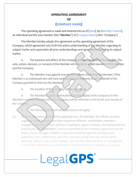How to Negotiate a Creative Services Agreement: Key Clauses and Red Flags to Watch For
A Creative Services Agreement is a critical contract that defines the working relationship between a creative professional and their client. Whether...
6 min read
LegalGPS : Nov. 23, 2025
Sarah Martinez thought hiring a graphic designer for her boutique fitness studio's rebrand would be straightforward. She found a talented freelancer online, agreed on a $3,500 fee, and expected fresh logos and marketing materials within six weeks. Four months later, Sarah was $8,200 poorer, had no usable designs, and faced a delayed studio opening that cost her $15,000 in lost revenue.


Legal GPS Pro
Protect your business with our complete legal subscription service, designed by top startup attorneys.
Sarah's story isn't unique. Graphic design projects fail at alarming rates, leaving business owners frustrated, financially strained, and legally vulnerable. The culprit isn't usually poor design skills—it's inadequate contracts that fail to protect either party when projects go sideways.
Understanding why design projects derail and how proper contracts prevent these failures can save your business thousands of dollars and months of headaches. More importantly, the right legal framework transforms creative collaborations from risky gambles into predictable business investments.
When graphic design projects fail, the financial damage extends far beyond the initial design fee. Business owners face cascading costs that can cripple operations and delay critical launches.
Consider the real expenses when design projects go wrong. Lost time represents the biggest hidden cost, as entrepreneurs spend countless hours managing disputes instead of growing their businesses. Marketing delays can cost thousands in missed opportunities, especially for seasonal businesses or product launches with hard deadlines.
Legal fees compound the damage when poorly written contracts force businesses into expensive disputes. Emergency redesign costs often exceed original budgets by 200-300% as desperate business owners pay premium rates for rushed work. Meanwhile, opportunity costs multiply as delayed launches push back revenue generation and market entry timing.
Marcus Chen hired a design agency to create branding for his three-location taco chain expansion. The $12,000 contract seemed comprehensive, but lacked specific deliverable descriptions and revision limits. When the agency delivered designs Marcus considered "completely off-brand," they demanded additional fees for revisions.
The dispute escalated over five months. Marcus paid $8,000 in legal fees, $18,000 for emergency rebranding with a different agency, and lost $7,000 in delayed grand opening revenue. The original agency kept the initial payment, citing contract terms that favored their interpretation of "creative differences."
A proper contract with detailed deliverable specifications, revision processes, and dispute resolution procedures would have prevented this $45,000 disaster entirely.
Design project failures follow predictable patterns that proper contracts can prevent. Understanding these common failure points helps business owners identify risks before signing agreements.
Scope creep tops the list of project killers. What starts as logo design expands into website graphics, business cards, and social media templates without corresponding budget adjustments. Clients assume additional work is included while designers expect separate compensation for expanded deliverables.
Unclear approval processes create endless revision cycles that drain budgets and extend timelines. Without defined stakeholders and decision-making authority, projects stall in committee reviews and conflicting feedback loops that frustrate everyone involved.
Identify exactly who has approval authority before design work begins. Specify whether one person makes final decisions or if committee approval is required. Include maximum committee size and decision timelines in your contract to prevent approval bottlenecks that derail project schedules.
Communication breakdowns poison even well-intentioned collaborations. Designers and clients often speak different languages when discussing creative concepts, leading to misaligned expectations and disappointing deliverables that satisfy no one.
Intellectual property confusion creates legal nightmares when project relationships sour. Clients assume they own all design work upon payment while designers may retain rights to concepts, fonts, or creative processes used in development.
Payment disputes predictably emerge when milestone structures aren't clearly defined. Designers demand payment for work-in-progress while clients withhold payment for unsatisfactory deliverables, creating cash flow problems that force project abandonment.
Jennifer Walsh's software startup paid $15,000 for logo design and brand identity from a freelance designer. Eight months later, when Jennifer tried to trademark her logo, she discovered the designer had used copyrighted elements without permission and retained ownership of the core design concepts.
The trademark application was rejected, and Jennifer faced potential copyright infringement claims from the original element creators. She paid $12,000 for new designs and $6,000 in legal fees to resolve intellectual property issues. The original designer refused refunds, claiming the contract only guaranteed "design services," not trademark-eligible work.
Clear intellectual property transfer clauses and originality guarantees in the initial contract would have prevented this $33,000 nightmare and protected Jennifer's brand development investment.
Effective graphic design contracts function as project roadmaps that prevent common failure points while protecting both parties' interests. Essential elements create clear expectations and enforceable remedies when problems arise.
Detailed scope definitions eliminate dangerous ambiguity about project deliverables. Contracts should specify exact items to be delivered, including file formats, color variations, size specifications, and usage rights for each element. Revision limits prevent scope creep while defining what constitutes a revision versus additional work.
Payment structures protect cash flow for designers while ensuring clients receive value before making full payment. Milestone-based payments tied to specific deliverables create accountability checkpoints that keep projects moving forward productively.
Include rough visual mockups or detailed descriptions of expected design styles in your contract appendix. This prevents "that's not what I envisioned" disputes by establishing concrete visual references that both parties can reference throughout the project development process.
Timeline specifications with defined consequences create urgency while allowing reasonable flexibility for creative work. Include buffer time for revisions and approvals while establishing clear deadlines that protect business launch schedules and marketing campaign timing.
Intellectual property transfer clauses must specify exactly when ownership transfers and what rights each party retains. Define whether transfer occurs upon final payment, delivery, or approval to prevent ownership disputes that can destroy business relationships.
Termination procedures protect both parties when collaborations become unworkable. Specify how work-in-progress is valued, what materials must be returned, and how partial payments are calculated to enable clean separations without legal battles.
David Kim's online clothing store needed branding for a holiday season launch. His designer contract included detailed deliverable specifications, three-round revision limits, milestone payments tied to approval stages, and automatic intellectual property transfer upon final payment.
When the initial designs missed the mark, the clear revision process allowed efficient feedback and adjustments without budget impacts. The milestone structure ensured the designer was compensated fairly while David retained leverage for quality control. The project completed on time and within budget, generating $180,000 in holiday revenue.
The comprehensive contract framework transformed a potentially risky creative collaboration into a predictable business investment that delivered measurable returns.
Recognizing warning signs before signing design contracts can prevent expensive disasters and protect business operations from creative project failures. Smart entrepreneurs learn to identify problematic situations before making financial commitments.
Vague project descriptions that use subjective language like "modern," "professional," or "eye-catching" without specific parameters indicate inadequate planning. Designers who resist detailed scope discussions or timeline commitments often struggle with project management and client communication.

Freelance Graphic Designer Contract
Use our Freelance Graphic Designer Contract Template to specify scope of work, deliverables, payment schedules, revision rounds, copyright ownership, and confidentiality for freelance design projects.
Trusted by 1,000+ businesses to safeguard their LLCs.
Pricing that seems too good to be true usually indicates corners being cut in quality, timeline, or legal protections. Extremely low bids may signal inexperienced designers, hidden costs that emerge later, or inadequate time allocation that guarantees rushed, unsatisfactory work.
Dr. Rebecca Torres hired a budget designer for $800 to create marketing materials for her dermatology practice. The designer delivered materials that violated medical advertising regulations and included stock photos used without proper licensing.
The state medical board fined Dr. Torres $12,000 for misleading advertising claims, and she faced a $25,000 lawsuit from the stock photo company for unauthorized commercial use. The original designer disappeared when legal issues emerged, leaving Dr. Torres responsible for all consequences.
A properly vetted designer with industry experience and comprehensive contracts would have prevented this $37,000 regulatory and legal nightmare through proper compliance review and licensing verification.
Preventing graphic design project failures requires proactive legal protection and strategic relationship management that starts before creative work begins. Smart business owners invest in proper contracts and professional vetting to avoid expensive problems.
Research designers thoroughly before making commitments. Review portfolios for work similar to your project needs and verify that displayed work was actually created by the designer. Check references from recent clients and confirm the designer has experience with your industry's specific requirements and regulations.
Ask potential designers to provide examples of work they've completed for businesses similar to yours. Industry-specific experience helps ensure compliance with regulations and understanding of target audience expectations that generic designers may miss completely.
Negotiate contracts that protect your interests while maintaining fair relationships with creative professionals. Include specific performance standards, quality benchmarks, and remedies for substandard work that protect your business investment without creating unreasonable designer liability.
Document all communications and decisions throughout the design process. Email confirmations of verbal agreements, approval records, and change requests create evidence trails that prevent disputes and facilitate resolution when disagreements arise.
Budget for contingencies that account for potential design failures and emergency alternatives. Set aside 25-30% of design budgets for potential overruns, legal fees, or replacement designers to ensure business operations aren't derailed by creative project problems.
Children's charity director Amanda Foster needed event materials for a major fundraising gala. She researched five designers, checked references, and negotiated a comprehensive contract with clear deliverables, revision limits, and contingency procedures.
When her chosen designer experienced a family emergency two weeks before the deadline, the contract's termination clause allowed clean separation with partial payment for completed work. Amanda's contingency budget and pre-vetted backup designer list enabled seamless transition to alternative providers.
The event materials were completed on time, the gala raised $85,000 for the charity, and comprehensive planning prevented what could have been a devastating operational failure during the organization's biggest fundraising opportunity.
Graphic design projects don't have to be business gambles that risk your money and timeline. The right legal framework transforms creative collaborations into predictable investments that deliver measurable value for your business.
Legal GPS provides comprehensive graphic design contract templates that protect your interests while maintaining positive working relationships with creative professionals. Our contracts include detailed scope definitions, payment protections, intellectual property safeguards, and dispute resolution procedures that prevent common project failures.
Don't let inadequate contracts destroy your design investments. Legal GPS Pro subscribers access expert contract templates, revision guidance, and professional support that ensures your creative projects deliver results without legal risks.

Legal GPS Pro
Protect your business with our complete legal subscription service, designed by top startup attorneys.
|
Premium Template
Single-use Template |
Legal GPS Pro
Unlimited Access, Best Value |
|
|
| Choose Template | Learn More |
| Trusted by 1000+ businesses | |
Table of Contents

A Creative Services Agreement is a critical contract that defines the working relationship between a creative professional and their client. Whether...

When agencies, freelancers, and creative professionals provide services to clients, one of the most important legal considerations is who owns the...

The photography industry has exploded in recent years, with talented professionals building thriving businesses around weddings, events, portraits,...